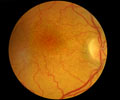Patients with radiation retinopathy who were destined to go blind within five years now can keep their sight longer through localized treatment with Avastin, a well-known cancer drug, according to a two-year study published in the June, 2007 Archives of Ophthalmology.
“This is a major breakthrough for eye cancer patients who are treated with radiation therapy and commonly develop radiation retinopathy,” said Paul T. Finger, MD, lead author of the study and director of Ocular Tumor Services at the New York Eye and Ear Infirmary. “Avastin reduces abnormal blood vessel growth, stops leakage in the eye and the patients wind up seeing better. This is a first.”Until now, patients with inflammation or cancer of the eye’s choroid, retina, orbit and paranasal sinuses were confronted with a catch-22 in terms of treatment. Radiation therapy is the treatment of choice for most patients; but, it commonly causes a troubling side effect -- radiation retinopathy.
Dr. Finger references in the study 6 patients who had plaque radiation therapy and developed radiation retinopathy, but he has now treated 28 patients successfully with Avastin, he says. “The drug improved or stabilized visual acuity in all cases by dramatically reducing blood vessel leakage and resultant swelling of the macula, the major causes of irreversible vision loss in radiation retinopathy,” he said. He also noted that, “before these Avastin findings, there was no effective treatment for macular radiation retinopathy.”
Avastin is a monoclonal anti-body which inhibits the formation of abnormal blood vessels by selectively blocking a substance known as vascular endothelial growth factor (VEGF). Avasitin (also called bevaciaumab) is used systemically (throughout the body) for some cancers and has been linked to the risk of stroke; but, in this new study, it was administered and stayed locally in the eye.
In February 2007, in a study published in The American Journal of Ophthalmology, Dr. Finger showed that treatment with Avastin had similar success in patients with radiation optic neuropathy.
The New York Eye and Ear Infirmary, the oldest specialty hospital in the Western Hemisphere, is the primary teaching hospital for the New York Medical College. It has approximately 142,000 outpatient visits annually and over 20,000 surgical procedures per year. It has one of the nation’s most extensive eye, ear, nose and throat clinics.
Advertisement
SRM/M










